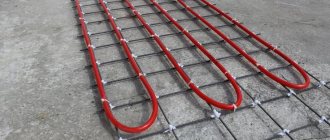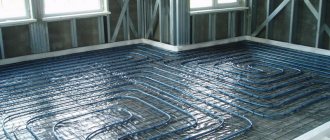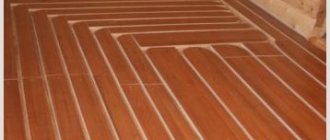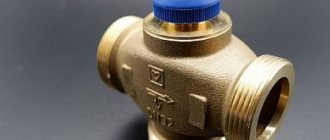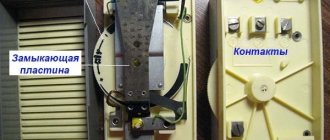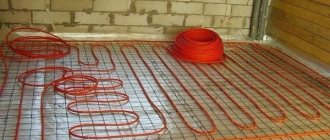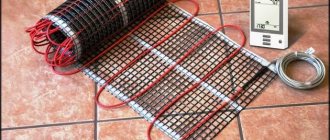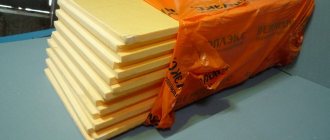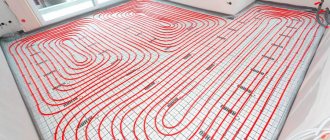An important element when installing heated floors is the thermal insulation material. Heat consumption and maintaining an optimal atmosphere in the room depend on it.
Lack of thermal insulation will lead to the formation of condensation, and this in turn will lead to dampness and mold. In addition, without this gasket, some of the heat will go down, thereby being wasted.
The most popular and modern thermal insulation product for heating systems is polystyrene foam.
What is expanded polystyrene
Expanded polystyrene is a foamed polymer substance. It is produced by foaming the mass by adding a low-boiling liquid to it. As a result, granules with a waterproof shell are formed.
Then, they are exposed to hot steam, which leads to their increase in size up to 30 times. The granules, connecting with each other, form polystyrene foam boards having a high density. This product is unique because, despite its lightness and airiness, it can withstand pressure and compression.
German scientists managed to obtain this material in the 20th century, as a result of the synthesis of styrene, a chemical substance that was released when Styrax resin was heated.
Rules for laying foil backing
Foil underfloor heating can be in rolls, mats or slabs. When laying, this coating must be joined both in length and width. In order for the connections to have the same properties, the fragments are glued together with special metallized (foil) tape. You must glue carefully, avoiding gaps, try to make the fit as precise as possible, without gaps.
When laying thin rolled foil material in a screed, the strips may overlap one another. The size of this “overlap” is at least 10 cm. This joint is glued twice on one side and on the other. We make cross connections according to the same rules.
It is recommended to use foil tape for connection.
When laying mats or slabs, they are joined close to one another, then glued with the same shiny tape. Some manufacturers make a lock along the edges of the slabs, which reduces the possibility of heat leakage through the joints. Despite this, we also glue the locking joints with tape. This makes it much more reliable.
Characteristics and advantages of polystyrene foam
Expanded polystyrene is better than other thermal insulation products, since its use produces a rigid and durable surface. It is similar to polystyrene foam, but has a denser structure with smaller cells.
The main positive properties of expanded polystyrene:
- the insulation has high moisture resistance and the ability to not allow vapor to pass through, which makes it possible to maintain thermal conductivity at the required level, even when the product is exposed to moisture;
- provides excellent sound insulation, which is an important condition when installing warm systems;
- environmentally friendly and not dangerous to humans;
- insulation prevents the development of fungus and mold;
- resistant to chemicals;
- retains operational properties at maximum temperatures, from - 50 to + 85 degrees;
- It is lightweight, which allows it to be used without the risk of weighing down the structure;
- easy to use: laying, trimming, processing, so you can do all the procedures yourself;
- fits on any base, as its surface is smooth;
- reduced level of thermal conductivity due to the bubble structure;
- has a waterproofing property, as it is resistant to moisture.
It should be said separately about the safety of the material - it does not burn and even has the ability to self-extinguish. But there is also a disadvantage of insulation - the release of toxic substances during smoldering.
Pros of reflective insulation
- Reasonable price with fairly high quality material;
- Easy to use. Installation does not require special skills or expensive tools;
- Compactness and elasticity of the material. Due to its compactness, it can be used in many different areas. And due to its elasticity, installation work in hard-to-reach places is simplified;
- Good hydro- and vapor barrier properties;
- Good noise absorption. We all like silence in the house; almost all types of reflective thermal insulation perfectly block out the majority of sounds from outside;
- Environmental friendliness. Does not cause harm to health, as it is made from safe materials;
- Fire resistance. All reflective insulators are made from fire-resistant materials;
- Durability. These materials do not rot, due to which they retain almost all of their heat-insulating properties for a very long time.
Parameters for choosing insulation, what we pay attention to
When purchasing floor heating from expanded polystyrene, you should take into account indicators such as: quality and variety.
Initially, the quality of polystyrene foam boards for heated floors is determined by their appearance. The following points should be taken into account:
- Color - should be bright and uniform, which indicates compliance with the technological process. Most often sold in blue or orange. The color scheme itself does not affect the characteristics of the product.
- Smell – a strong odor is unacceptable, a slight, slight specific odor may be present.
- The shape is clear geometric, and the edges are smooth and do not crumble.
- The granules are the same size without voids.
- The surface is flat, otherwise the thermal insulation qualities will be reduced.
For your information! Experts recommend especially inspecting the place of the cut or break. If the granules are intact in this area, we can talk about their poor adhesion to each other. In a high-quality slab, when broken, the granules should also be destroyed.
What foam density to choose for floor screed
Now manufacturers produce such material with a density of 15, 25, 35, 50 (kg/cubic meter).
And for the floor (in residential buildings) it is recommended to use polystyrene foam with a density of at least 35. That is, 35 is just right .
Some builders use 25th density and claim that for residential buildings (that is, when NOT industrial premises are insulated) this is enough. Well, perhaps...
However, you will still have to make a thicker screed and, most likely, reinforce it.
If this suits you, then you can use 25th density. We are leaning towards 35th density foam . We believe that this is the best option for the floor.
In addition, keep in mind an important point :
When choosing polystyrene foam for the floor, you need to pay special attention to the quality of the material
In this case we are talking specifically about density. The fact is that some manufacturers deceive consumers. And, for example, instead of foam plastic with a density of 35, they sell a material that actually has a density of 25. And instead of 25th, they can slip in 15th density. Do you understand the meaning?
Thus, they provide themselves with more income. It’s not for nothing that builders have long used such concepts as “honest 25th” polystyrene foam, “honest 35th”...
That is, there may be one brand indicated on the packaging, but in reality it is lower. At the same time, some manufacturers act honestly and do not deceive buyers. And they sell honestly. Their polystyrene foam densities are fair.
Therefore, keep in mind... So that it doesn’t turn out that when you buy 25-density foam for the floor, you actually get only 15-density. It will be very disappointing. And such material for the floor, naturally, is not suitable.
And exactly the same: if you buy the 35th, you can get the 25th.
Thus, purchasing grade 35 polystyrene foam for a floor screed is more appropriate . Including taking into account the possibility of deception on the part of manufacturers and sellers. Even if they deceive you, the density will be about 25, which can still be tolerated somehow...
In general, when purchasing material, pay special attention to its quality. Choose only reliable, trusted manufacturers and sellers.
Further…
Analogs of expanded polystyrene
There are a number of materials that can also be used as thermal insulation, but their characteristics are significantly inferior to expanded polystyrene.
These include:
- Cork slab - has a high cost.
- Mineral wool does not tolerate moisture well, is not suitable for installation on the ground, and is contraindicated when installing a heated water floor.
- Foamed polyethylene - the heaviness of the screed leads to a significant reduction in its thickness.
- Polystyrene foam is a less suitable material for warm floors, as it has a fragile structure and insufficient rigidity. It can be used in warm systems, but when there is no load.
Good to know! Despite the claims of manufacturers, polystyrene foam, especially when installing a heated water floor, requires good waterproofing. Otherwise, the degree of thermal insulation will significantly decrease under the influence of moisture.
Recommendations for installation
Before starting installation work, you need to decide on the thickness of the thermal insulation layer. Keep in mind that in a private house you will need a larger layer of insulation (from 1 to 3 cm) than in heated apartments. For apartments, the recommended thickness is up to 1 cm.
Do not forget to lay moisture-proofing layers to avoid the accumulation of liquid in the layers of the heated floor.
Polystyrene foam as a type of thermal insulation is an excellent budget option for installation in all types of houses, combining reasonable prices and good insulating qualities. Do not forget about the rules for choosing and installing materials, this will greatly simplify your task.
- Related Posts
- What myths exist about the dangers of heated floors?
- How to install a heated floor in a toilet?
- How does radiant floor heating work?
- How is an infrared heated floor installed?
- Features of installation of heated floors Sun power
- How to choose a thermostatic valve for underfloor heating?
Kinds
The quality of expanded polystyrene is influenced by production technology; various characteristics of the material and laying features depend on it. Several types of polystyrene are available.
Profile (expanded polystyrene mats)
Expanded polystyrene slabs, which were developed specifically for these systems, have gained particular popularity when installing heated floors. The main advantage of the mats is the special bosses located on their surface; they significantly simplify the installation of heating elements, since no additional parts are required for their fastening.
The positive aspects of such plates:
- the presence of a rigid vapor barrier polystyrene foam layer - protects against condensation;
- mats that have a foil laminated coating - it protects against the action of chemicals contained in the screed;
- light weight and size - simplifies installation;
- have side locks - a monolithic structure without acoustic and cold seams is obtained;
- the presence of a relief surface on the reverse side - allows you to smooth out small roughnesses of the base and creates conditions for its ventilation;
- service life (50 years) - provided that the underfloor heating system is properly operated;
- The thickness of the slab does not change under the weight of the screed.
Foil polystyrene
Expanded polystyrene with a foil layer is primarily intended for heated floors. Reflective foil helps to heat the room more efficiently, as heat is transferred evenly from the floor surface upward.
When installing a heated water floor, polystyrene foam must have a foil layer. The installation process will be facilitated by the use of foil polystyrene.
Advantages of this product:
- thermal resistance to temperature changes;
- excellent sound insulation;
- moisture resistance;
- does not emit toxic substances when heated;
- not subject to rotting.
Important! This material is contraindicated when installing infrared heated floors.
Unpressed
Unpressed polystyrene foam is made by molding a composition that is pre-dried and foamed at +80 degrees.
This is the cheapest material and is also the most fragile.
Video - laying insulation under a heated floor
Laying polystyrene foam on the floor
Extruded thermal insulation material
The extrusion process involves squeezing the mixture through an extruded device with heads into a slab shape, followed by drying. A reagent is first introduced into the material, leading to active foaming.
EPPS is a new variety, produced in the form of technoplex and premium foam. Today, extruded insulation for underfloor heating is becoming increasingly popular.
EPS is an ideal option as a substrate for heated floors, as it does not emit toxic substances from heating, and is considered the best heat insulator. However, it is quite fragile and is not a good sound insulator.
Pressed and autoclaved
Pressed material is similar to extruded material, but differs in production technology.
The manufacturing technology is the same, but the foaming of the granules is carried out in an autoclave. Autoclaved polystyrene is not suitable for thermal insulation of heated floors.
Watch the video
Floor insulation with polystyrene foam TechnoNIKOL
The main types of insulation for underfloor heating
Rolled polyethylene foam substrates
Let's start with the simplest and most inexpensive material. True, with a caveat - its use can hardly be considered a full-fledged replacement for other insulation materials used in “warm floor” systems. But for some types of such systems, and in certain conditions, this is enough.
“Isoline Warm floor” - already in the name of the material its purpose is immediately indicated.
We are talking about foamed polyethylene sheets. Very often, the front side of the material (for some types, both sides) is covered with foil or polymer film with a reflective effect. This also contributes to ensuring that heat flows are directed in the right direction.
Most of these substrates are made of polyethylene foam. The material is a collection of a huge number of air bubbles, isolated from each other by thin polyethylene walls. This determines the main qualities of the material - its lightness, flexibility, plasticity, high resistance to heat transfer (thermal conductivity coefficient lies in the range of 0.035÷0.05 W/(m×℃)), noise-absorbing abilities.
True, not everything is as good with mechanical strength, in particular with compression forces. High compressive loads will simply flatten such a fabric, and in matters of thermal insulation, thickness is always of decisive importance (the thermal resistance itself is calculated from the thermal conductivity coefficient and the thickness of the layer). That is, if such a material is poured on top with a massive screed, then its thermal insulation capabilities, which are already small due to its small thickness, will sharply decrease.
Nevertheless, such insulation is widely used. In those “warm floor” systems that are created only to increase comfort, without pretending to provide general heating. And in conditions where the base of the floor already has a sufficient degree of insulation or the ceiling is located above a constantly heated room.
A classic example is infrared film “warm floor”. It is not immured in the screed, it is located directly under the finishing coating (laminite, parquet, linoleum), separated from it only by a thin layer of waterproofing.
Approximate diagram of a “warm floor” with infrared heating film
1 – the base of the floor (which has its own insulation) or the ceiling above the heated room that does not require special insulation. In other cases, such a scheme will be extremely ruinous.
2 – a layer of rolled polyethylene foam insulation with a reflective surface, thickness from 3 to 10 mm. Ten millimeters is too much, as the floor may begin to “play” under your feet. Typically a thickness of up to 5 mm is practiced.
3 – infrared film heating elements.
4 – mandatory layer of waterproofing (polyethylene film, usually at least 200 microns thick).
5 – finishing floor covering.
It is in such conditions that the foil surface, which reflects the propagation of infrared waves towards the room, becomes very important.
Thin foil insulation seems to be specially created for such “warm floors”
A couple more important notes can be made about the reflective layer.
Such insulation is sometimes covered with mortars. For example, when ceramic tiles are laid on top of rod infrared heaters, a layer of adhesive about 10 mm thick is obtained.
- So, firstly, thin aluminum foil is eaten by the alkaline environment of cement mortars literally in a matter of days. That is, the reflective effect simply will not remain.
— Secondly, open foil is a current conductor. And when installing electric heaters on such a substrate, you need to correctly understand what can happen if the wiring breaks down.
The solution in both cases is roll insulation, covered not with foil, but with reflective Mylar film. It is not afraid of chemical exposure and is a dielectric. By the way, these are the types of insulation that are now on sale – the majority.
Several brands of such insulation are shown in the table:
| Name of material | Penofol | Ecofol | Isoflex | Izolon |
| Illustration | ||||
| Thermal conductivity coefficient, W/m×°С | 0,049 | 0,049 | 0,036 | 0.040 |
| Density, kg/m³ | 35 | 33 | 35 ÷ 45 | 27 ÷ 33 |
| Thermal reflectivity | at least 90% | at least 80% | at least 90% | up to 95 ÷ 97% |
| Operating temperature range | from -60° to +100°С | from -60° to +90°С | from -60° to +80°С | from -80° to +80°С |
| Vapor permeability, mg/m×h×Pa | no more than 0.001 | no more than 0.001 | no more than 0.001 | no more than 0.001 |
| Release form | Thickness 2, 4, 5 mm with a reflective layer of 14 microns - rolls 1.2 × 30 m; thickness 8 and 10 mm – rolls 1.2 × 15 m | Rolls 1200 mm wide, insulation thickness 2, 3, 5, 8 and 10 mm, length 25 and 15 m. | Rolls are 1200 mm wide, insulation thickness is 2, 3, 5, 8 or 10 mm, length is 25 and 15 m. The thickness of the reflective layer is 10 microns. | The width of the canvas is 1.5 m, thickness 2, 3, 4, 5, 8 and 10 mm. Roll lengths are, respectively, 200, 170, 130, 100, 80 and 50 m. It is possible to purchase individual sheets with a thickness of 15 mm, dimensions 1500 × 2000 mm |
Expanded polystyrene boards
These materials can also be classified as the simplest inexpensive solutions. This refers to the use of polystyrene foam slabs for flooring under a warm floor. More specifically, either blocks of ordinary white polystyrene foam (which is much cheaper), or panels made of an extrusive variety of this material.
The simplest white polystyrene foam attracts precisely because of its low cost - workshops for its production are available almost everywhere, and there are no problems with supply or any complex logistics.
The heated floor is installed over a layer of laid ordinary foam plastic boards. Available and cheap, but too many shortcomings.
The material is available in different densities, but for the conditions under consideration it is better to take polystyrene foam of at least 50 kg/m³. A lower density can cause higher fragility of the insulation, which must withstand considerable load under the screed.
It would seem - why not a solution? Meanwhile, this approach is not particularly favored. There are many reasons for this.
- First of all, precisely because of the simplicity of the technology for producing polystyrene foam, the low cost of raw materials and the minimum necessary equipment, it is mass-produced in semi-underground workshops and workshops. Where, of course, we haven’t heard of any GOST or TU requirements. The likelihood of purchasing poor-quality or even hazardous material is extremely high!
- Further, expanded polystyrene produced using this granule foaming technology is not chemically stable, and during operation a reverse depolymerization process may begin. That is, the foam literally crumbles into dust. Again, this most likely happens with slabs produced without proper technological control.
- Not very good for white foam with resistance to breaking loads.
In a word, this approach has a right to exist, especially when using certified boards, for example, the PSB-S-50 brand. But if possible, it is advisable to look for something better.
Such a solution could be slabs of extruded polystyrene foam (EPS or XPS). The raw materials are the same, but the production technology is radically different. And the characteristics of the material are also much higher - both in terms of strength and durability, and in matters of thermal insulation and safety in operation.
As an example, we can cite the slabs of the famous Russian brand “Penoplex”, the name of which has already become a household name. And it is often used for all EPS panels in general.
Penoplex slabs and installation of a heated floor contour on an insulating layer made of such slabs
| Material parameters | Extruded polystyrene foam boards "Penoplex-Comfort" | Foam plastic PSB-S-50 |
| Illustration | ||
| Thermal conductivity (W/m oC) | 0,028 ÷ 0,034 | 0,039 ÷ 0,050 |
| Vapor permeability (mg/m×h×Pa) | 0.007 | — |
| Water absorption over 24 hours in % of volume | 0.4 | 0.6 |
| Ultimate strength at static bending MPa (kg/cm²) | 0,4 ÷ 0,7 | 0,07 ÷ 0,20 |
| Compressive strength 10% linear deformation, not less than MPa (kgf/cm²) | 0,25 ÷ 0,3 (2.5÷3) | 0,15 ÷ 0,2 (1,5÷2) |
| Density (kg/m³) | 28 ÷ 35 | 35 ÷50 |
| Operating temperatures | -50 to +75 | |
| Fire resistance category | G1 | G4 |
| Standard dimensions, mm: | ||
| - lenght and width | 600 ×1200 | 1000 ×1000 |
| - thickness | 20; 30; 40; 50; 60; 80; 100 | from 20 to 200 |
So, the solution, in principle, is not bad, but still does not provide the master with the advantages that materials specially designed for heated floors provide.
Film-coated polystyrene boards
It would seem – is there a big difference, with coating or not? It turns out it's big...
Each such slab, after being laid on the floor, becomes an almost completed section of insulation, already covered with waterproofing and ready for pouring screed. Moreover, many manufacturers immediately apply a dimensional grid on the top film or foil coating. And this greatly simplifies the process of marking and subsequent laying of pipe or cable circuits,
Agree that when there is such a “coordinate grid” on the floor surface, laying pipes will become much easier.
The form of release of such insulation materials is also interesting. These can be simply panels similar to ordinary polystyrene foam. But it is much more convenient to use special mats, which are well-fitted parts “hinged” together with a film. Such insulation materials roll out over the surface like a tank caterpillar, or are laid out like a children's accordion book. In this case, the fragments that make up the mat are immediately fitted very tightly to each other. All that remains is to tape the joint lines between adjacent mats with tape - and in a matter of minutes the floor is covered with both insulation and waterproofing with coordinate markings.
Folding insulation mats for heated floors
Such mats are made of dense polystyrene foam, extruded or pressed, and they hold harpoon staples well, which can be used to fix pipes or cables along the intended lines. This, you see, is another convenience.
Fastening the pipe circuit to the insulated surface with special harpoon brackets.
However, many craftsmen prefer to tie pipes or cables to the reinforcing mesh under the screed. You can also use special mats, which will be discussed in the next subsection of the article.
In the meantime, here are several varieties of folding thermal insulation mats for “warm floors”:
| Options | PS 50125 | "Energoflex Energofloor Tacker TP" | “Penoroll – 35” (based on extruded polystyrene foam) | "Rehau Rautak" |
| Illustration | ||||
| Thermal conductivity coefficient, W/m×°С | 0.036 | 0.034 | 0.032 | 0.035 |
| Dynamic strength, kgf/cm² | 3,0 | 5,5 | 6,0 | 5,0 |
| Noise absorption, dB | 23 | 23 | 27 | 25 |
| Dimensional parameters, mm: | ||||
| - width | 1000 | 1000 | 600 | 1000 |
| — roll length | 5000 | 2000 (roll or “book”) | 5000 | up to 12000 (roll or “book”) |
| - thickness | 25 | 25 | 20 | From 20 to 70 |
| — grid step | 50 | 50 | 100 | 50 |
Profile mats
They can perhaps be called the most convenient for “warm floors”. The reason is obvious - the mats perform not only an insulating mission - they also allow you to securely fasten pipes without the use of any additional devices.
The fact is that such mats have a special relief. The parts of this relief (they are often called either bosses or working projections) are placed in such a way and have such a shape that the heating circuit pipes are perfectly fixed between them.
Profile mats provide both insulation and the basis for quick, convenient and reliable pipe laying.
These mats are also made from polystyrene foam, but using a special stamping technology. And the bosses on their surface have very impressive strength properties. In any case, you can safely walk on them in shoes, and the pipe fixed by them will not move either during installation or later, when the floor is poured with concrete screed.
In fact, the master can lay out the contour of the pipes alone, without even bending down to the floor surface. I laid out a section of pipe unwound from the coil along a pre-designed “trajectory”, and then lightly pressed it with my foot into the gap between the clamping bosses. That's all!
There are no additional operations - laying the contour can be done by one person.
By the way, such mats very often have interlocking connections, that is, they are very easily assembled into a common unbroken surface. In addition, the film coating can overlap adjacent mats, that is, thereby creating a single waterproofing layer
After joining in such a lock, there will be no “cold bridge” or leaking seam along the joint line.
Such mats are currently produced in a very wide variety of thicknesses, relief shapes, designed for various pipe diameters, equipped with or without a film coating. That is, it gives you the opportunity to purchase the optimal model based on your needs and capabilities.
Several options are in the table below:
| Options | "Rehau Varionova 30-2" (Germany) | "Format" (Russia) | "Ekopol 20" (Russia) | FT 40208 (Russia) |
| Illustration | ||||
| Thermal conductivity coefficient, W/m×°С | 0,037 | 0,036 | 0,035 | 0,035 |
| Overall dimensions, mm | 1450×850 | 815×615 | 1100×800 | 1000×500 |
| Thickness of the insulation layer, mm | 30 | 20 | 20 | 20 |
| Height of bosses, mm | 20 | 20 | 18 | 20 |
| Total mat height, mm | 50 | 40 | 38 | 40 |
| Applicable pipe diameter, mm | from 14 to 17 | from 14 to 20 | until 17 | Up to 20 |
| Laying pitch, mm | multiples of 50 | multiple of 150 | multiples of 50 | multiples of 50 |
| Coating | stretched waterproofing film | Available without coating and with a top film layer | durable black film coating | green film coating |
| Design Features | hermetic locking connection between mats | stamped lock connection | hermetic locking connection between mats, double density of material on the bosses | digitized marking scales along the perimeter, embossed lower surface to smooth out unevenness and enhance the sound insulation effect. |
* * * * * * *
The publication deliberately does not discuss some other insulation materials often used in construction. The reasons are different. Or the material is not effective enough to provide the required thermal insulation value on a thin layer (and sometimes the struggle is for every centimeter). Or the insulation lacks rigidity, as, for example, is the case with mineral wool. There are no words, and among basalt wool there are very dense brands that can withstand high loads. But their cost makes this approach completely unprofitable - polystyrene foam with similar thermal resistance indicators is quite sufficient.
Natural cork is a very good insulation material. But pouring this expensive, unique material with a concrete screed looks “blasphemous.” Products of innovative technologies, PIR boards, one might say, the current “champions” in terms of insulation qualities, probably have a great future, but for now they remain a very expensive “pleasure”.
So the average owner of a house or apartment, one way or another, will have to choose insulation for a “warm floor” from those discussed in this article.
And at the end of the publication, there is a video that once again reminds of the need for insulation and provides an algorithm for calculating its required thickness.
Where installation is allowed
Expanded polystyrene is recommended as insulation where an increase in the load on the load-bearing floors of the room is unacceptable, and in cases with low ceilings. During construction work, polystyrene foam is used to insulate:
- water pipeline;
- roofing;
- floor;
- door and window slopes;
- walls.
For example, thermal insulation of pipe materials with polystyrene foam for water-heated floors is considered financially justified due to its properties.
In addition, the use of block polystyrene foam makes it possible, in case of problems, to gain access to the pipeline by removing a separate section of the coating. For the same reason, the product is often installed when constructing warm electric floors.
Functions of construction mats
Expanded polystyrene for underfloor heating ensures the proper functioning of the heating structure. To do this, it is important to provide a good base for the warm water floor. Mats help distribute heat over the entire surface and retain it even after the energy supply for the functioning of the heated floor is stopped.
Also, such mats provide complete insulation from cold air. Thus, during cold weather, cold will not penetrate into a room with a warm water floor. Condensation does not form if such a substrate is present. Accordingly, there is no mold on the walls either.
Material structure Source allelectrics.ru
What kind of base is it placed on?
Floor insulation with extruded polystyrene foam // FORUMHOUSE
Expanded polystyrene is an affordable type of thermal insulation; it contributes to the normal functioning of the “warm floor” system. The material can be laid on various substrates:
- sand-crushed stone - obtained by compacting soil;
- gravel - which is compacted and protected from moisture;
- concrete - equipped with a waterproofing coating;
- wooden - flooring with waterproofing.
For your information! It is forbidden to use mixtures containing solvent or bitumen mastic as a waterproofing layer on the base of polystyrene; under their influence, the insulation may be destroyed.
Flooring installation
A finishing layer of coating is laid on top of the prepared layers. The following can be used as a finishing coating:
- various types of linoleum;
- laminate;
- parquet;
- carpet and others.
When laying tiles and coatings that are not distinguished by hardness, an additional layer is laid in the form of chipboard sheets or plywood. The sheets are fixed at the edges with small glass nails (if the base is made of wood) or fastening dowels (for a concrete base).
After laying all the necessary components, the floor is put into operation.
How to lay polystyrene foam under a heated floor
Do-it-yourself water heated floor. Installation of expanded polystyrene
Laying polystyrene as a substrate for a heated floor should begin with rough preparation of the base; it should be smooth and clean. If necessary, you should pour a concrete screed if this is required by the installation technology of this type of heated floor.
Then, you can lay a special anti-acoustic film, it will provide excellent sound insulation. The next layer of the cake is waterproofing, it can be a simple plastic film. To avoid cracking of the screed when heated, damper tape should be glued around the perimeter of the room. After which, work directly on insulation begins.
Let's look at laying polystyrene slabs for heated floors using the example of a private house:
- plywood or boards are laid on which the logs are installed, and polystyrene foam is placed between them;
- if the insulation is laid on a screed, then the slabs are placed at the joint, and the seams are taped;
- on top of the mats are covered with vapor barrier and waterproofing material;
- an additional sheathing is installed across the joists; it will facilitate ventilation circulation;
- the next layer is laid sheets of plywood;
- guides are mounted from slats, between which the heating elements are laid out;
- if a water system is installed, then foil with a thickness of at least 30 microns is laid on the pipes, or the entire floor area is covered with foiled polyethylene;
- then, the structure is covered with plywood or OSB sheets - using the dry method, or a screed is poured.
Now you can proceed to installing the flooring.
If you use expanded polystyrene slabs with bosses as insulation, then the work of installing a heated floor is greatly simplified.
Heating elements must be placed in the grooves of the mats and covered with a layer of waterproofing. On top of which plywood is installed, or screed is poured. And you can begin installing the flooring.
For your information! When installing rigid slabs on compacted gravel, additional moisture protection must be used.
Features when laying
- Before installing thermal insulation, it is necessary to prepare the floor, pour a concrete-cement screed and level it.
- If you place a special anti-acoustic film, you will provide yourself with an excellent level of noise insulation.
- After completing the previous steps, polystyrene foam slabs are laid so that they can move freely.
- We cover the floor with a waterproofing film (if its thickness is less than 0.2 mm, you will not get a good effect). At joints, it is recommended to apply the film layer on layer for greater effectiveness.
- Next, the concrete floor screed is applied again, the layer should be at least 5 cm.
- The last stage is laying the finishing coating, such as linoleum, parquet, etc.
Coolant mounting methods
There are different ways to attach the coolant when installing heated floors:
- Reinforcing mesh - water system pipes or electrical cables are secured to the mesh with plastic ties. In places where the heating elements are bent by 90 degrees, 2 pieces of tie are enough, and when turning by 180, you need to fix them in 3 places.
The advantages of this method are ease of operation and reliability. The disadvantages are the labor-intensive process, the possibility of damage to the pipe materials on the mesh during operation of the system, if they are made of metal-plastic. In addition, the thermal efficiency of the floor may be reduced due to voids between the pipes and the mesh.
- Plastic guides - placed on polystyrene foam with a smooth surface. They can be different in length, connected by inserting one into the other, and secured with clasps. Before fixing them, you should decide on the layout of the heating elements. To secure the guides, plastic brackets are used, which are installed on polystyrene.
The advantages are the speed and convenience of laying out pipe-rolling materials and their reliable fixation. Disadvantages - the marking process is complicated and there is no mesh to reinforce the screed.
For your information! It is possible to make guides yourself from wooden slats.
- Plates with bosses - no additional fixation is required, since the bosses are guide parts, the coolant is laid between them according to any pattern. The mats make it easier to install pipe materials, and the bosses protect them from damage. The main disadvantage is the high price of the slabs.
- The use of Velcro is a new method of fastening. Fixation is done by wrapping the pipes with adhesive tape, which is attached to the base. This method is quick and convenient and does not require additional fixation. The downside is that installation becomes more complicated due to the lack of markings, and slight shifting is possible when walking on the floor.
Everyone can choose a thermal insulation material for heated floors, a method of arrangement and fixation of the coolant according to their wishes and financial capabilities.
People who have experience in working with thermal insulation can install extruded polystyrene foam themselves without foil, fastenings and markings. If you do not have this experience and do not rely on your own strength, then you should invite specialists to install a warm system with a polystyrene foam backing.
Nuances of fastening and installation
When laying foil insulation, you may need the following tools and materials:
- nails with large heads;
- stapler;
- hammer;
- construction tape.
When installing insulation with foil, it is important to avoid the mistake of laying the material with the shiny side down. In this case, the material will not perform its heat-reflecting functions. The foil side must “look” into the room in order to be able to return thermal energy to the room.
An example of laying lag on foil insulation
Advice! You can leave a small air gap between the insulation and the floor covering. Then the floors will be even warmer.
It is also important to remember that the insulation does not overlap. The sheets should be placed end to end and secured with tape or nails, depending on the type of base. Insulation with an adhesive layer may not be additionally fixed, but it is still recommended to secure it with fastening materials. All joints after laying the material are taped.
Thermal insulation for heated floors
Work on laying insulation can be dry or wet. In the second case, the material will be filled with concrete screed. In the first one, it is advisable to install an additional waterproofing layer.

